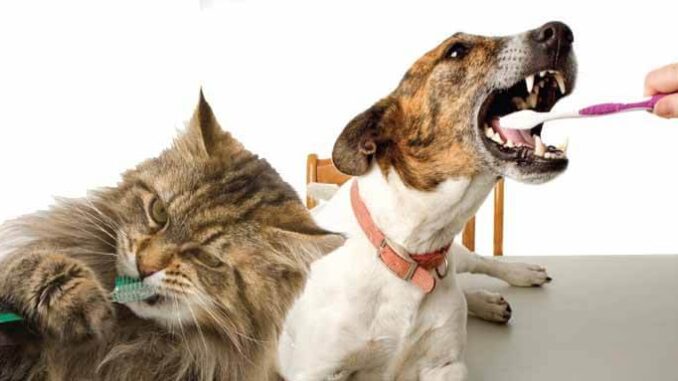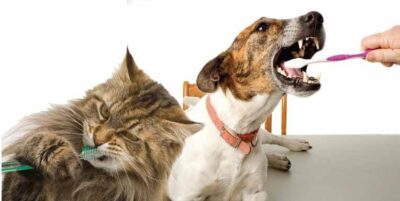
Oral health is just as important for your pets as it is for humans. While it may be easy to overlook your pet’s teeth, poor oral hygiene can lead to a number of serious health issues. Dental disease is one of the most common conditions affecting dogs and cats. In fact, by the time pets are three years old, more than 80% of them have some form of dental disease. Proper oral care can help prevent painful and costly conditions, ensuring your pet remains healthy and happy.

The Importance of Oral Health in Pets
Oral diseases, such as periodontal disease, can cause a variety of problems for your pet. If left untreated, they can lead to tooth loss, bad breath, difficulty eating, and even affect vital organs like the heart, liver, and kidneys. The bacteria from plaque and tartar buildup can enter the bloodstream, causing serious systemic health issues.
By taking the time to care for your pet’s teeth, you are not only preventing these problems but also contributing to their overall health and well-being. Healthy teeth also make it easier for your pet to eat, which can improve their nutritional intake and energy levels.
Signs Your Pet May Have Oral Health Problems
Before we dive into how to maintain your pet’s oral health, it’s important to recognize the signs of potential oral health issues:
-
Bad breath (halitosis): A common sign of oral disease.
-
Difficulty eating or chewing: If your pet hesitates to eat hard food or drops food while eating, this may indicate pain or discomfort.
-
Red, swollen, or bleeding gums: Healthy gums should be pink and not inflamed.
-
Excessive drooling: While some drool is normal, excessive salivation can be a sign of an infection or tooth problem.
-
Loose or missing teeth: As pets age, they may lose teeth, which is often a result of poor dental care.
-
Pawing at the mouth: If your pet is constantly pawing at their face or mouth, they may be experiencing pain.
-
Changes in behavior: If your pet seems more irritable or reluctant to play, it may be due to dental discomfort.
How to Maintain Your Pet’s Oral Health
Maintaining your pet’s oral health involves a combination of daily care, professional vet visits, and good dietary habits. Here’s a step-by-step guide on how to maintain their dental health:
A. Regular Brushing
One of the best ways to ensure your pet has healthy teeth and gums is by brushing their teeth regularly. Brushing removes plaque and prevents tartar buildup, which can lead to gum disease.
-
Start early: Introduce your pet to brushing from a young age, even if it’s just a few minutes a day. This will help them become accustomed to the process.
-
Use pet-specific toothpaste: Never use human toothpaste, as it contains ingredients that are toxic to pets. Pet toothpaste comes in flavors like chicken, peanut butter, or beef, which can make brushing more enjoyable for your pet.
-
Choose the right brush: There are special pet toothbrushes available with soft bristles and angled heads to make brushing easier. Alternatively, you can use a finger brush for a more gentle approach.
-
Brush gently: Brush in circular motions, paying special attention to the gum line where plaque tends to build up. Aim to brush at least 3-4 times a week, but daily is ideal.
B. Dental Chews and Toys
Dental chews and toys are a fun and effective way to help clean your pet’s teeth. These products are designed to help remove plaque and massage gums while your pet chews. Look for products that are approved by the Veterinary Oral Health Council (VOHC), which ensures they meet specific standards for effectiveness.
-
Chew toys: Choose toys that are durable yet soft enough to prevent injury to your pet’s teeth. Rubber or nylon toys can be great for cleaning teeth and satisfying chewing instincts.
-
Dental chews: There are a wide variety of chews available in different shapes and flavors. These chews help remove plaque and freshen breath. Be sure to select the appropriate size for your pet.
-
Edible dental treats: Some pet treats are formulated specifically to promote oral health, like treats that reduce tartar buildup or help control bad breath.
C. Regular Vet Checkups and Professional Cleanings
Even with regular brushing and dental care at home, your pet should have their teeth checked by a veterinarian at least once a year. Professional cleanings allow your vet to remove tartar and plaque that can’t be removed with regular brushing.
-
Dental exams: During a dental exam, the vet will check for signs of gum disease, cavities, tooth fractures, and other issues.
-
Anesthesia-free cleanings: Some clinics offer anesthesia-free dental cleanings, but these are not as thorough as those performed under anesthesia, which allows the vet to fully examine and clean every part of the mouth.
-
X-rays: If necessary, your vet may perform dental X-rays to check for any underlying issues, such as abscesses, infections, or bone disease.
D. Dental Diets
Some specialized pet food is designed to promote dental health by reducing plaque buildup and helping to clean your pet’s teeth as they eat. These foods contain larger kibbles or are formulated with special textures that scrape off plaque as your pet chews.
-
Dental kibble: Some brands offer dental-specific kibble that is made with ingredients to reduce tartar and improve oral health.
-
Water additives: There are water additives available that can help reduce bacteria in your pet’s mouth, promote fresh breath, and support overall oral hygiene.
E. Provide Fresh Water
Hydration is an essential part of oral health. Always make sure your pet has access to fresh, clean water. Drinking plenty of water helps to wash away food particles and bacteria from the teeth and gums, reducing the risk of plaque buildup.
Common Dental Problems in Pets
Pets can experience a range of dental issues, some of which are preventable with proper care. Here are some common problems:
-
Periodontal Disease: The most common dental problem in pets, characterized by inflammation and infection of the gums and teeth. It can lead to tooth loss if untreated.
-
Tartar and Plaque Buildup: Plaque is a sticky film of bacteria that forms on teeth. If not removed, it hardens into tartar, which can lead to gum disease and other complications.
-
Tooth Abscesses: Bacterial infections can cause pus to collect at the root of the tooth, leading to pain, swelling, and discomfort.
-
Broken or Chipped Teeth: Pets, especially dogs, may break or chip teeth while chewing on hard objects, leading to potential infections.
READ ALSO: The Importance of Nail Trimming for Your Pet
FAQs
How often should I brush my pet’s teeth?
Ideally, you should brush your pet’s teeth every day. However, brushing at least three times a week can significantly improve their oral health.
Can I use regular human toothpaste on my pet?
No, human toothpaste contains ingredients like fluoride and xylitol that are toxic to pets. Always use toothpaste specifically formulated for pets.
Are dental chews effective?
Yes, dental chews can be very effective at reducing plaque and tartar buildup. Look for products that are approved by the Veterinary Oral Health Council (VOHC).
What are the signs that my pet needs a dental cleaning?
Signs include bad breath, red or swollen gums, excessive drooling, difficulty eating, or pawing at the mouth. If you notice these symptoms, it’s time to visit the vet.
Leave a Reply
You must be logged in to post a comment.